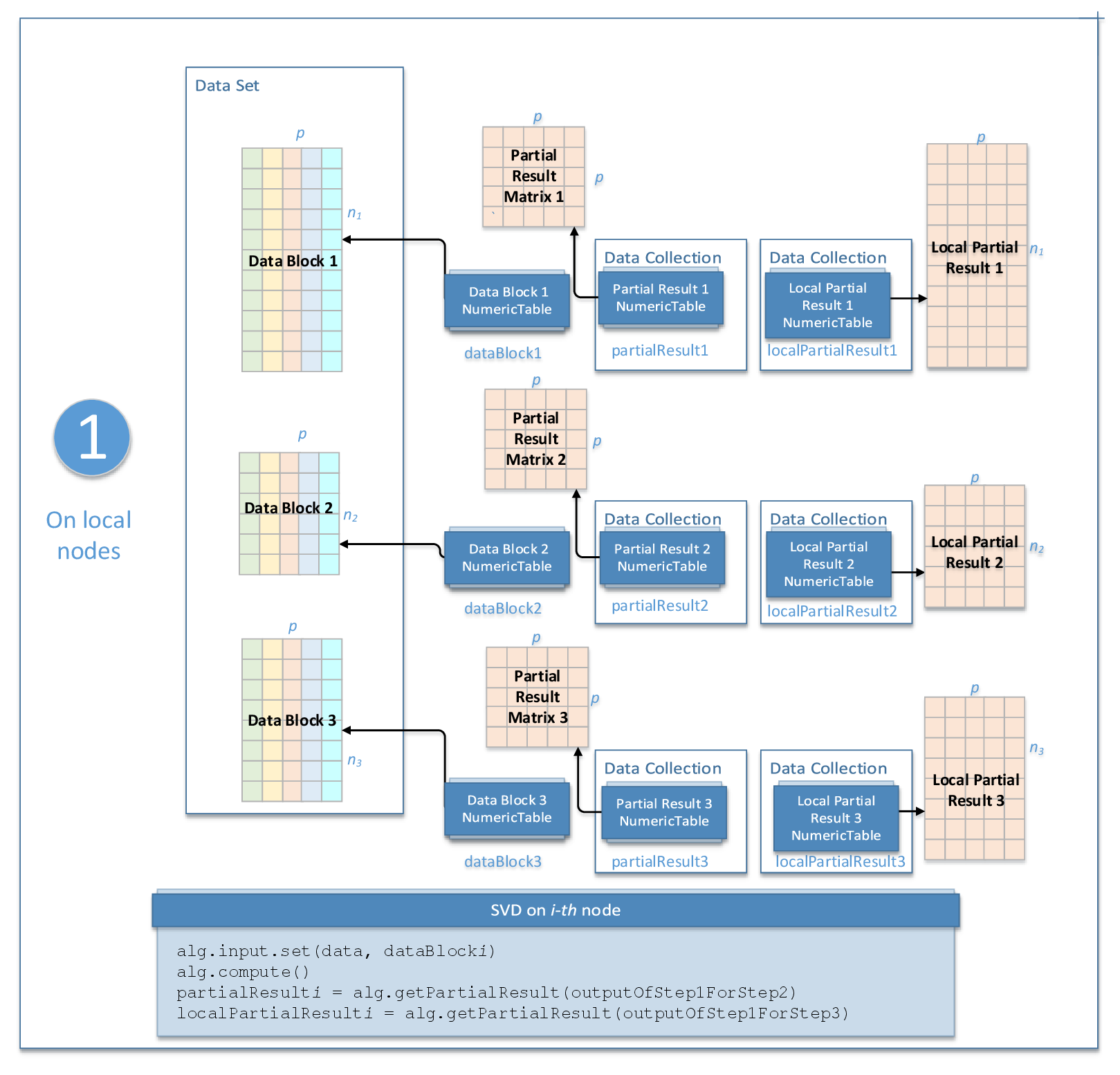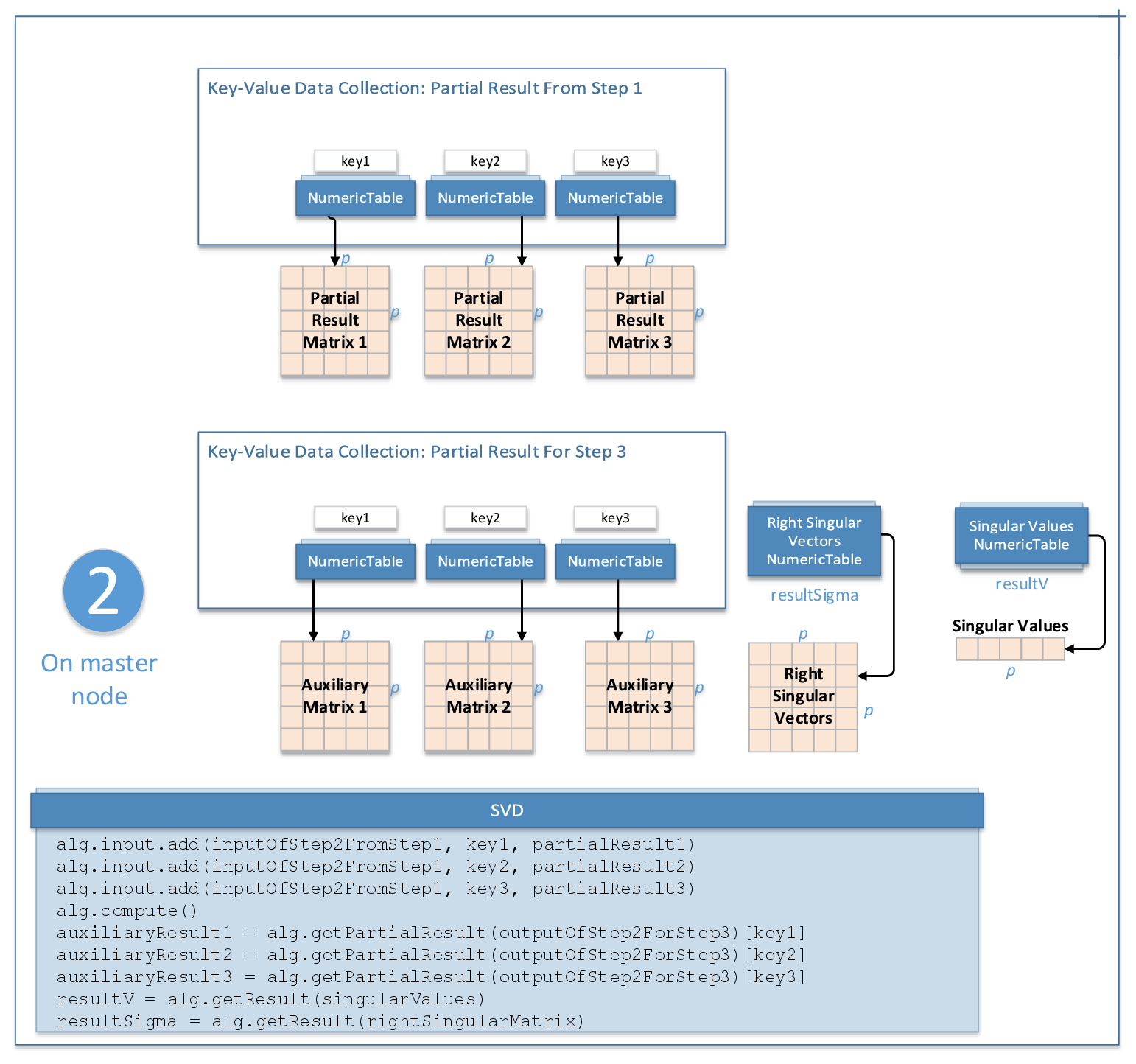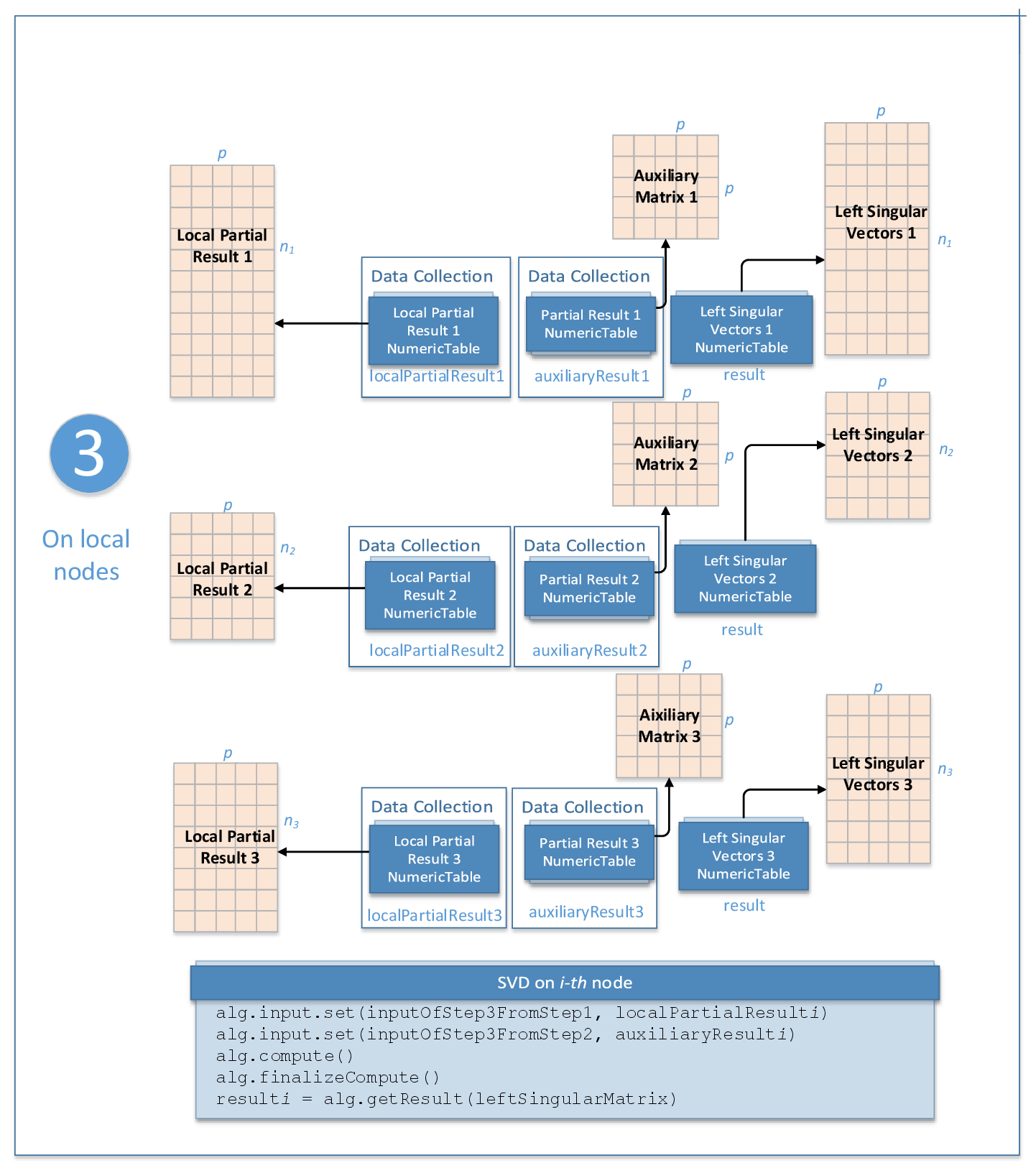This mode assumes that data set is split in nblocks blocks across computation nodes.
Algorithm Parameters
The SVD algorithm in the distributed processing mode has the following parameters:
|
Parameter |
Default Value |
Description |
|
|---|---|---|---|
|
computeStep |
Not applicable |
The parameter required to initialize the algorithm. Can be:
|
|
|
algorithmFPType |
double |
The floating-point type that the algorithm uses for intermediate computations. Can be float or double. |
|
|
method |
defaultDense |
Performance-oriented computation method, the only method supported by the algorithm. |
|
|
leftSingularMatrix |
requiredInPackedForm |
Specifies whether the matrix of left singular vectors is required. Can be:
|
|
|
rightSingularMatrix |
requiredInPackedForm |
Specifies whether the matrix of right singular vectors is required. Can be:
|
|
Use the three-step computation schema to compute SVD:
Step 1 - on Local Nodes

In this step, SVD accepts the input described below. Pass the Input ID as a parameter to the methods that provide input for your algorithm. For more details, see Algorithms.
|
Input ID |
Input |
|
|---|---|---|
|
data |
Pointer to the ni x p numeric table that represents the i-th data block on the local node. Note that each data block must have sufficient size: ni > p. The input can be an object of any class derived from NumericTable. |
|
In this step, SVD calculates the results described below. Pass the Partial Result ID as a parameter to the methods that access the results of your algorithm. For more details, see Algorithms.
|
Partial Result ID |
Result |
|
|---|---|---|
|
outputOfStep1ForStep2 |
A collection that contains numeric tables each with the partial result to transmit to the master node for Step 2. By default, these tables are objects of the HomogenNumericTable class, but you can define them as objects of any class derived from NumericTable except PackedSymmetricMatrix, PackedTriangularMatrix, and CSRNumericTable. |
|
|
outputOfStep1ForStep3 |
A collection that contains numeric tables each with the partial result to keep on the local node for Step 3. By default, these tables are objects of the HomogenNumericTable class, but you can define them as objects of any class derived from NumericTable except PackedSymmetricMatrix, PackedTriangularMatrix, and CSRNumericTable. |
|
Step 2 - on Master Node

In this step, SVD accepts the input from each local node described below. Pass the Input ID as a parameter to the methods that provide input for your algorithm. For more details, see Algorithms.
|
Input ID |
Input |
|
|---|---|---|
|
inputOfStep2FromStep1 |
A collection that contains results computed in Step 1 on local nodes (outputOfStep1ForStep2). The collection can contain objects of any class derived from NumericTable except the PackedSymmetricMatrix class and PackedTriangularMatrix class with the lowerPackedTriangularMatrix layout. |
|
|
key |
A key, a number of type int. Keys enable tracking the order in which partial results from Step 1 (inputOfStep2FromStep1) come to the master node, so that the partial results computed in Step 2 (outputOfStep2ForStep3) can be delivered back to local nodes in exactly the same order. |
|
In this step, SVD calculates the results described below. Pass the Partial Result ID or Result ID as a parameter to the methods that access the results of your algorithm. For more details, see Algorithms.
|
Partial Result ID |
Result |
|
|---|---|---|
|
outputOfStep2ForStep3 |
A collection that contains numeric tables to be split across local nodes to compute left singular vectors. Set to NULL if you do not need left singular vectors. By default, these tables are objects of the HomogenNumericTable class, but you can define them as objects of any class derived from NumericTable except PackedSymmetricMatrix, PackedTriangularMatrix, and CSRNumericTable. |
|
|
Result ID |
Result |
|
|
singularValues |
Pointer to the 1 x p numeric table with singular values (the diagonal of the matrix Σ). By default, this result is an object of the HomogenNumericTable class, but you can define the result as an object of any class derived from NumericTable except PackedSymmetricMatrix, PackedTriangularMatrix, and CSRNumericTable. |
|
|
rightSingularMatrix |
Pointer to the p x p numeric table with right singular vectors (matrix V). Pass NULL if right singular vectors are not required. By default, this result is an object of the HomogenNumericTable class, but you can define the result as an object of any class derived from NumericTable except PackedSymmetricMatrix, PackedTriangularMatrix, and CSRNumericTable. |
|
Step 3 - on Local Nodes

In this step, SVD accepts the input described below. Pass the Input ID as a parameter to the methods that provide input for your algorithm. For more details, see Algorithms.
|
Input ID |
Input |
|
|---|---|---|
|
inputOfStep3FromStep1 |
A collection that contains results computed in Step 1 on local nodes (outputOfStep1ForStep3). The collection can contain objects of any class derived from NumericTable except the PackedSymmetricMatrix and PackedTriangularMatrix. |
|
|
inputOfStep3FromStep2 |
A collection that contains results computed in Step 2 on local nodes (outputOfStep2ForStep3). The collection can contain objects of any class derived from NumericTable except PackedSymmetricMatrix and PackedTriangularMatrix. |
|
In this step, SVD calculates the results described below. Pass the Result ID as a parameter to the methods that access the results of your algorithm. For more details, see Algorithms.
|
Result ID |
Result |
|
|---|---|---|
|
leftSingularMatrix |
Pointer to the n x p numeric table with left singular vectors (matrix U). Pass NULL if left singular vectors are not required. By default, this result is an object of the HomogenNumericTable class, but you can define the result as an object of any class derived from NumericTable except PackedSymmetricMatrix, PackedTriangularMatrix, and CSRNumericTable. |
|